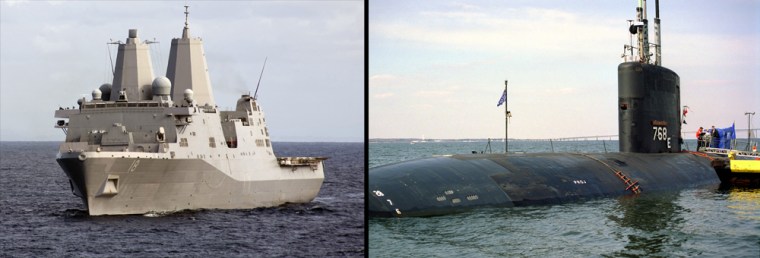Two U.S. Navy vessels — a nuclear-powered submarine and an amphibious ship — collided before dawn Friday in the mouth of the Persian Gulf, one of the world's most important sea passages for oil supplies.
There was no damage to the sub's nuclear propulsion system and no disruption to shipping in the strategic Strait of Hormuz, through which a fifth of the world's oil passes, said Navy spokesman Lt. Nate Christensen, with the Bahrain-based 5th Fleet.
The incident happened around 1:00 a.m. local time Friday (5 p.m. EDT Thursday), when the USS Hartford, a submarine, and the USS New Orleans, an amphibious ship, collided in the narrow Strait of Hormuz, the 5th Fleet said in a statement.
The New Orleans suffered a ruptured fuel tank, resulting in a spill of approximately 25,000 gallons of diesel fuel, Christensen said.
According to the Bahrain-based 5th Fleet, 15 sailors aboard the Hartford were slightly injured but able to return to duty. No injuries were reported aboard the New Orleans, and both ships are operating under their own power.
"The spill is closely monitored," Christensen said. "The lightweight diesel, although obviously a fairly substantial amount of gasoline, likely dissipated in the ocean."
'Major mistake'
Military analyst Loren Thompson of the U.S.-based Lexington Institute said a collision between two vessels in the world's most sophisticated navy is nearly unheard of. It's more common for ships of different navies to collide, or military vessels and commercial ships, he said.
"It's almost inevitable that people are relieved of duty pending investigation," Thomson told The Associated Press by phone. "These sort of accidents are so uncommon that you have to take it for granted that a major mistake occurred by one of the vessels' captains."
Both ships were heading to port and were going in the same direction when the incident occurred in the narrow Hormuz, said Christensen. He said the submarine was submerged at the time but that he could give no further details as the collision is still under investigation.
Later Friday, the vessels were on their way to port for repairs and evaluation, added Christensen. Following standard security procedures he could not say where the vessels were headed.
Hormuz at its narrowest is 34 miles wide, but the location of the collision was not disclosed.
The two ships were on regularly scheduled deployments to the region and conducting security operations, the Navy said. The Hartford is based in Groton, Conn., and the New Orleans is based in San Diego. As all U.S. submarines, the Hartford is nuclear-powered. The New Orleans is an amphibious transport dock ship.
As much as 17 million barrels of oil a day went through the narrow strait in the first half of 2008, or about 40 percent of all seaborne traded oil or 20 percent of all oil traded globally.
More on: |
